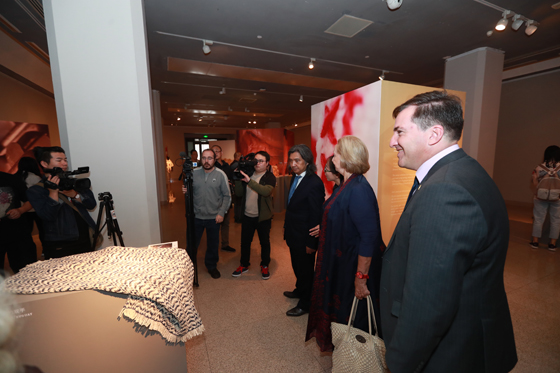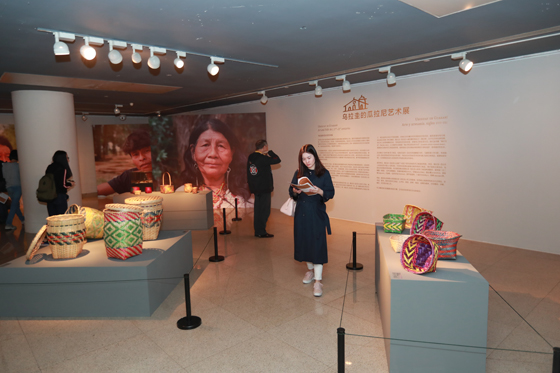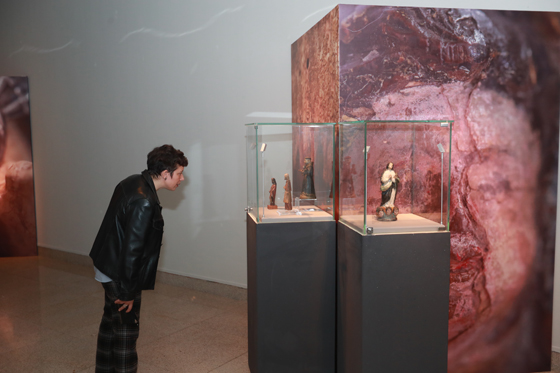Exhibition of "Uruguay in Guarani, Art and Folk Art, 17th-21st Centuries"Held at NAMOC
Source:: Time:2018年04月25日
Year of 2018 coincides with the 30th Anniversary of the Establishment of Diplomatic Relations between the People’s Republic of China and the Oriental Republic of Uruguay. Co-hosted by NAMOC, Museum of Pre-Columbian and Indigenous Art and Embassy of Uruguay to China, Exhibition of “Uruguay in Guarani, Art and Folk Art, 17th-21st Centuries” has been held at several halls on the fifth floor of NAMOC since April 20, 2018. This exhibition is also one of the important cultural events in celebration of the 30th Anniversary of the Establishment of Diplomatic Relations between China and Uruguay.
On behalf of NAMOC, Mr. Wu Weishan, Director of NAMOC, expresses his gratitude for the presence of all Chinese and foreign guests. According to him, spiritual exchange is the most important exchange between countries, between nations or between peoples. Culture is the vital carrier for spiritual expression. Thanks to emotion expression through culture, “Separated as we are thousands of miles apart, we come together as if by predestination”. Therefore, cultural exchange is not only the most profound exchange, but also the most far-reaching and the most long-lasting exchange, which is the best bridge which can integrate emotions and souls with each other. Mr. Wu Weishan once again thanked Uruguayan colleagues for sending so many treasures for the purpose of exhibition at NAMOC. This exhibition deserves to be an important node for continuous advancements and bright prospects on the basis of the 30th anniversary of friendly ties between the Chinese and Uruguayans.
As introduced by Ms. María Julia Muñoz, Minister of Culture and Education of Uruguay, within the framework of the 30th Anniversary of the Establishment of Diplomatic Relations between China and Uruguay, this grand exhibition, which focuses on Guarani Culture of Uruguay since the 17th century, officially makes debut in China, a cradle for one of the oldest civilizations for thousands of years. This is of great significance for consolidating cultural exchanges between both countries. Then she promises that Uruguay will establish the first-ever “Chinese Cultural Center” to help Uruguayans know more about China and Chinese culture. It is believed that under strong support of NAMOC, “Chinese Cultural Center” will be bound to make new contributions to the cultural and artistic exchanges between both countries.
Mr. Facundo de Almeida, Director of Museum of Pre-Columbian and Indigenous Art, thanks NAMOC for affording this rare opportunity to display the Uruguayan national artworks in the great and preeminent China. He shows gratitude for joint efforts by both museums for this successful exhibition. According to him, this exhibition not only casts light on Pre-Columbian and Indigenous Art in Uruguay, Baroque artworks of the 17th and 18th centuries, but also showcases those Guarani artworks by Uruguayan contemporary artists.
Guarani Art of Uruguay, which goes down in history since the 17th century, is highlights of this exhibition. The Guarani were the main indigenous people of South America before Spain and Portugal established colonial rule in the 15th century. Nowadays, they scatter across Uruguay, Paraguay, Brazil and Argentina. The Guaraní constitute the dominant indigenous group in Uruguay, and they are still a major part of the population of Uruguay. Moreover, the Guarani are also the one and only ethnic group in Uruguayan territory that retains indigenous customs.
The exhibition will showcase 158 pieces (sets) of Guarani handicrafts, including 18 sculptures in Baroque-Guarani style, 12 pieces (sets) of Mate tea set, 43 pieces (sets) of traditional Mbia-Guarani folk artworks and 85 pieces (sets) of contemporary Uruguayan folk artworks (including daily necessities, apparels, accessories, etc). From three dimensions, these exhibits demonstrate Guarani folk art tradition and its contemporary transformation. At the same time, the exhibition will also showcase contemporary daily necessities, artworks, apparels and personal adornments in unique styles, which are deeply influenced by Mbia-Guarani handicrafts. These handmade products are made of wood, bark, leather, pumpkin and metal by means of engraving, embossing, weaving, knitting and dyeing. As can be found from their patterns and visual elements, they are in the forefront of global pop culture.
According to Mr. Wu Weishan, cultural and artistic exchanges facilitate the closer people-to-people bonds, while the peoples’ communication is ever-increasingly strengthened. This time, introduction of Guarani art at NAMOC allows the Chinese visitors to get a rough idea on Uruguayans’ living conditions and spiritual world in the past four centuries. As an important cultural event in celebration of the 30th Anniversary of the Establishment of Diplomatic Relations between China and Uzbekistan, this exhibition opens new horizons and blazes new paths for strengthening mutual understanding and advancing friendship between the peoples.
According to Mr. Facundo de Almeida, this exhibition at NAMOC is an important opportunity to help Chinese visitors gain insights into culture profile of Uruguay, a distant country from China, which will be undoubtedly continuous booster for the friendly relations and cultural exchanges between China and Uruguay. Mr. Fernando Lugris (Uruguayan Ambassador to China) also comments: “Cultural and educational exchanges can make our country more prosperous. We are very happy to let the Chinese visitors get to know the historical origin of our country. This exhibition will emerge as a cultural landmark for China and Uruguay”.
In the past three decades, China and Uruguay launch exchange and cooperation in various fields through various means. Especially in the cultural field, the different cultural traditions and cultural characteristics of both countries offer multiple possibilities for further mutual exchanges. This exhibition will further give impetus to dialogues and exchanges between China-Uruguay cultures. This well-planned exhibition and a galaxy of exhibits will also let Beijing visitors enjoy a dramatic art feast.
This exhibition, entitled “Uruguay in Guarani, Art and Folk Art, 17th-21st Centuries”, is held at NAMOC Hall 19-21 until May 5, 2018. (Closed on Mondays)




